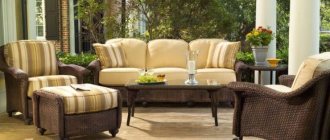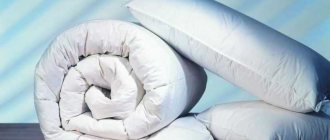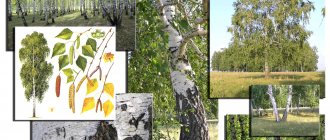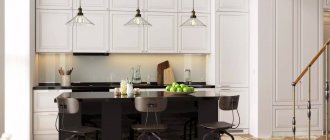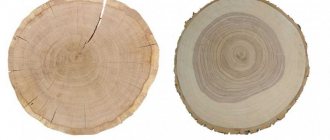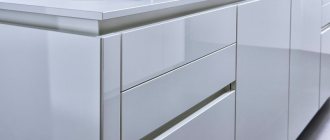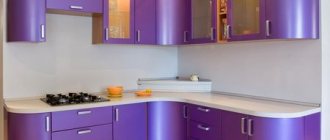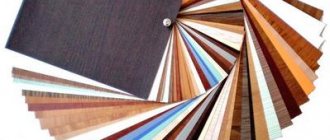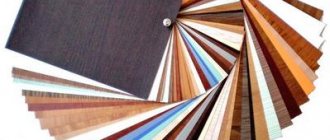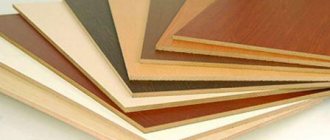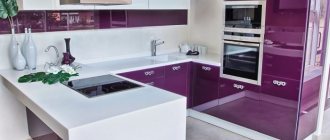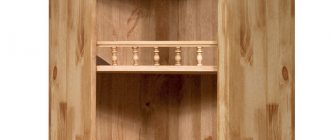Let's be honest, over the years of work, our clients often ask us the same questions, but among this cohort of questions, one in particular stands out, it is asked so often that we are already quite tired of answering it. This question torments many who are faced with a difficult choice - which solid wood to choose, and in general which wood is best for furniture. The problem is really not a joke, since there are about 25 thousand different types of wood around the globe. But only about 30 of them are used in construction and repair work of residential premises and houses, as well as in furniture production. Therefore, within the framework of this material, let’s still try to answer questions that are so important for us: “Which wood is best for furniture?”
And before we begin our excursion into the study of different types of wood, we need to find out what distinguishes them from each other, what characteristics have a special impact on the use of wooden furniture.
Choosing wood for furniture
If you want to emphasize the aesthetics of solid wood, then do not forget that wood can be hard, porous and moisture resistant. If you lose sight of this fact, you may find yourself in a situation where many different troubles may arise during the operation of solid wood furniture. If you are faced with a choice of which type of wood to choose from for future furniture, then it will be useful for you to know that hard and dense types of wood are distinguished by excellent performance qualities, but this plus also results in an essential disadvantage - hard wood types are very difficult to process, as a result of which when producing furniture from these species, one has to resort to the use of expensive specialized equipment, and therefore the price is commensurately higher than furniture made from soft wood.
Wood species for furniture are divided into three categories:
- Soft - up to 540 kg/kb. m - chestnut, linden, poplar, aspen, pine, fir, alder, cedar, almost all conifers.
- Solid - 550-740kg/kb. m – apple tree, larch, maple, plane tree, ash, oak, elm, beech, birch, walnut.
- Particularly (very) hard - from 750 kg/kb. m – hornbeam, yew, rowan, boxwood, white acacia, pistachio tree, dogwood, iron birch.
Therefore, let us take a detailed look at those species that are most in demand in furniture production.
Clean and harmless
Anyone who has experienced all the “benefits” of Chinese furniture (oh that lingering smell of plastic and glue!) understands that products made from synthetic materials are by no means as harmless as manufacturers present them to us.
By the way, not all wooden furniture is equally useful. If the product is made of laminated veneer lumber, veneer or plywood, then harmful formaldehyde compounds may be used as a binder. They are safe exactly until the moment when the furniture starts to heat up, for example, from a nearby heating radiator or stove. Formaldehyde released negatively affects genetics, reproductive function, respiratory tract, eyes, skin and the central nervous system. Thus, if you have to choose between furniture made from synthetic materials and supposedly environmentally friendly products made from laminated wood using glue that contains formaldehyde, it is better to choose the first option.
But not all glue is equally harmful. Classic PVA will not cause any negative health effects. Thus, when choosing furniture made from glued wood, find out what the product is held together with. As a rule, the manufacturer indicates the composition of the glue in the instructions.
Furniture made from natural wood is fastened with steel bolts, self-tapping screws or PVA glue. All these fastening methods are used in different furniture depending on the expected load.
Remember that not all types of wood are equally suitable for making furniture. Find out what type of wood the product is made from. Pine, alder and birch are suitable for making simple furniture, although in our country almost all products are traditionally made from these types of wood: from beds to cabinets.
Durable and reliable furniture is made from oak, beech and cherry. An oak bed can last hundreds of years if you properly care for this furniture.
By the way, we recommend that you choose furniture made of larch. This type of wood deposits biologically active compounds that eliminate free radicals and prevent colds.
Pine
Pine wood has different color shades, the most common are brown, beige-yellow, white with light pink stains. Pine has found its application in various areas of production - windows, doors and facade elements are made from its wood. But among other things, pine wood is very popular in the field of cladding ceilings and walls; in addition, it is used to create stairs and floors that are not too loaded. Pine furniture is famous for the fact that it radiates a lot of heat into the surrounding interior, stored by the wood, and despite the fact that it darkens a little over time, this does not in any way affect its beauty. It has long been noted that furniture made from untreated pine brings some natural charm to the home.
According to the masters themselves, they consider pine, which grows on hills with sandy soils or on dry hills, to be the best material for making furniture. This is due to the fact that the annual layers of such a pine will be pronounced and very narrow, located very close to each other. But pine, which grew in areas with high humidity, will have wood with a very loose structure, for this reason, blanks from this pine must be dried for a very long time before it is put into production. Pine wood is a soft wood, and therefore you should not be surprised at how easily it is scratched and damaged.
Advantages of pine:
- Pine lends itself well to processing, as it is easily planed along the grain, but difficult to plan in the transverse direction. When cutting, things are slightly different - cutting a log across is easy, but cutting along it is difficult.
- Pine is easy to glue;
- Pine wood can be used either for the production of furniture directly, followed by varnishing, or for the creation of various structures and frames, which can subsequently be covered with hardwood veneer, in this case it all depends on its color and structure;
- Pine has a pleasant coniferous smell and releases phytoncides, which are considered medicinal.
Larch
The color of larch is amber-yellow with compact growth rings. Larch is moisture resistant and does not respond to temperature changes. Due to its high flexibility, bent fragments can be made from the material.
Pine
Pine is a budget option. The wood is soft, has a golden hue and a characteristic pattern. The material is wear-resistant, durable, easy to process. Natural essential oils have a beneficial effect on humans; phytoncides destroy pathogens in the air. To avoid damaging the soft surface, you must handle objects carefully.
Birch
High-quality furniture for children's rooms with allergies is made from solid birch. The wood lends itself well to processing and can withstand significant mechanical loads. Birch is the best option for making household items yourself.
Wooden furniture needs proper care. To maintain an elegant appearance and reliability, it is necessary to remove dirt with a soft damp cloth, use special cleaning products, do not place hot objects on the surface, remove moisture, and regularly use protective agents.
Spruce
In terms of hardness, spruce wood is in many respects inferior to pine, but at the same time the tree is very resistant to the appearance of cracks in its structure, the so-called cracking. The color of spruce wood ranges from uniform white to yellowish or reddish white. Due to the high content of resins in spruce wood, it is used in the manufacture of sauna cabins. But there are also factors that significantly complicate the processing of spruce in the production of furniture panels from its wood: a large number of knots located on the tree trunk. Compared to pine, spruce absorbs moisture better and, as a result, rots faster. Spruce wood is most often used for mosaic finishing or in structures that do not experience significant loads during use, this is due to the fact that it has a subtle texture and low strength.
Pros of eating:
- Spruce is practically not subject to warping;
- Like pine, spruce lends itself perfectly to gluing.
How to choose wood based on hardness, density, moisture resistance
Determination of hardness a - according to Brinell; b – according to Rockwell
Furniture made from durable material is practical in use. It is less likely to be scratched. The production of durable products requires a lot of labor, significant material costs, and certain skills in working with wood.
Wood hardness by species (table - list)
Interestingly, not all durable varieties are resistant to moisture. There are soft breeds that have good resistance to moisture.
Furniture made from dense wood that is not resistant to moisture will lose its presentable appearance in a couple of years and turn into a ruin, unsuitable for subsequent restoration.
Oak
Oak wood is hard and heavy. It is characterized by excellent mechanical properties and high abrasion resistance. The colors of oak wood are most often tan, gray-brown and light red. On a radial section of an oak trunk, large pith rays and light sapwood are clearly visible. Oak is the most widely used hardwood in the manufacture of solid wood furniture, due to its excellent combination of strength and beautiful texture. Oak is considered a noble wood and is mainly used in the production of durable luxury furniture. Oak furniture is durable and can last for many decades. If an oak tree lies in water for a long time (several decades), its wood acquires a rare dark purple color with a green tint. Oak wood is difficult to polish and requires equipment with highly hardened cutters.
Advantages of oak:
- despite the high viscosity of wood, it is processed quite well;
- bends easily;
- resistant to rotting;
- lends itself well to artificial aging techniques.
Areas of application
Due to their properties, valuable species are widely used in the woodworking industry and construction. Carpenters especially often work with them. Also used for the production of household goods, jewelry boxes, kitchen utensils, and weapons.
It is also a useful raw material for creating various sports equipment, barrels, boxes, benches, thresholds, and toys.
This is another incomplete list of those areas in which I use valuable species.
Valuable breeds are widely used in furniture, pharmacological, military and many other fields. Such trees are distinguished not only by their attractive appearance, but also by their unique characteristics. That is why their cost is higher than ordinary breeds.
Beech
Beech wood is hard and very smooth, but at the same time elastic and very durable. Beech is excellent for making furniture due to the fact that it can be bent and given the desired shape by pre-treating it with steam. This ease of working with beech is due to its homogeneous structure. Beech wood is white in color with some yellowish-red tint, which turns to pinkish-brown over time. Beech wood can be used not only in furniture production, but also for making parquet, serving as a floor covering. The main disadvantage of beech is the fact that due to exposure to moisture it is greatly deformed, so beech furniture is suitable only for interior spaces.
Beech advantages:
- Beech wood has excellent decorative qualities, due to the beautiful texture of the wood both in radial and tangential cuts;
- Beech dries quickly and does not crack at all;
- Beech is easy to process;
- Beech wood is perfectly bleached and painted without changing the beautiful natural shade when varnished.
Cons of beech:
- it is highly hygroscopic, therefore it is not recommended for the manufacture of furniture that will be used in conditions of high humidity (bathtub, kitchen);
- Poorly polished.
Common birch
Even if we take into account the fact that birch wood has high rates in terms of rigidity, this does not prevent it from being very elastic and having quite excellent flexibility. The color of birch wood ranges from reddish-white to yellowish. It is worth noting, however, that one of the significant disadvantages of birch wood is its tendency to warp, cracks, takes a long time and does not dry well, and is susceptible to wormholes. Birch is often used in the production of veneer and plywood. Often, when decorating furniture with decorative elements, birch is found in combination with dark-colored wood.
Advantages of common birch:
- Common birch wood has a uniform structure and beautiful color;
- Birch lends itself well to bending;
- It can be used in the manufacture of solid wood furniture to imitate valuable species, as it is perfectly colored when wood is etched.
So, what is the answer to the question posed earlier - Which wood is best for furniture? It is very difficult to get an unambiguous answer, since any of the above-mentioned types of wood will perfectly suit the situation that interests you; for this difficult reason, many choose wood in accordance with the purpose of the furniture. But if you need beautiful furniture that will serve you faithfully for many years, then you simply need to give preference to wood species with high hardness values, for example, oak wood, then your furniture will be strong, elegant and will serve you faithfully for many, many years .
Properties of valuable wood species
Valuable species are superior to common construction trees due to certain features, because they:
- stronger and have a longer service life;
- look more beautiful and noble;
- have a unique pattern and unique ring design.
What is the reason for the richness of patterns? Increased layer density.
